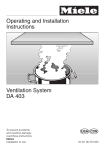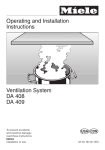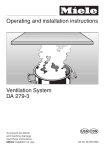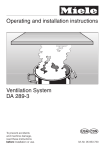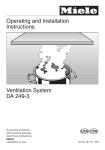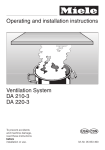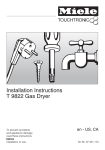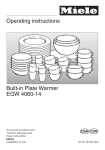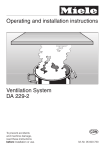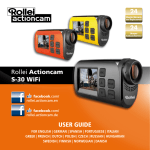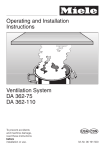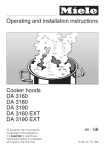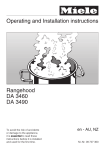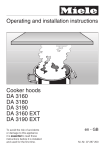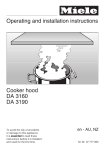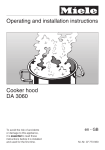Download Miele M 326 EG Operating instructions
Transcript
Operating and Installation Instructions Ventilation System DA 326-1 i DA 329-1 i To prevent accidents and machine damage, read these instructions before installation or use. UV M.-Nr. 05 864 020 2 Contents IMPORTANT SAFETY INSTRUCTIONS . . . . . . . . . . . . . . . . . . . . . . . . . . . . . . . . . 4 Guide to the hood . . . . . . . . . . . . . . . . . . . . . . . . . . . . . . . . . . . . . . . . . . . . . . . . . 8 Functional description . . . . . . . . . . . . . . . . . . . . . . . . . . . . . . . . . . . . . . . . . . . . 10 Operation . . . . . . . . . . . . . . . . . . . . . . . . . . . . . . . . . . . . . . . . . . . . . . . . . . . . . . . 11 Turning the fan on . . . . . . . . . . . . . . . . . . . . . . . . . . . . . . . . . . . . . . . . . . . . . . . . . 11 Selecting the power level . . . . . . . . . . . . . . . . . . . . . . . . . . . . . . . . . . . . . . . . . . . 11 Turning the fan off . . . . . . . . . . . . . . . . . . . . . . . . . . . . . . . . . . . . . . . . . . . . . . . . . 11 Turning the light on . . . . . . . . . . . . . . . . . . . . . . . . . . . . . . . . . . . . . . . . . . . . . . . . 12 Turning the light off . . . . . . . . . . . . . . . . . . . . . . . . . . . . . . . . . . . . . . . . . . . . . . . . 12 Cleaning and care . . . . . . . . . . . . . . . . . . . . . . . . . . . . . . . . . . . . . . . . . . . . . . . . 13 Cleaning the casing . . . . . . . . . . . . . . . . . . . . . . . . . . . . . . . . . . . . . . . . . . . . . . . . 13 Grease filter . . . . . . . . . . . . . . . . . . . . . . . . . . . . . . . . . . . . . . . . . . . . . . . . . . . . . . 13 Inserting / replacing the active charcoal filters . . . . . . . . . . . . . . . . . . . . . . . . . . . 16 Changing the light bulbs . . . . . . . . . . . . . . . . . . . . . . . . . . . . . . . . . . . . . . . . . . . . 17 After Sales Service . . . . . . . . . . . . . . . . . . . . . . . . . . . . . . . . . . . . . . . . . . . . . . . 18 Installation instructions . . . . . . . . . . . . . . . . . . . . . . . . . . . . . . . . . . . . . . . . . . . 19 IMPORTANT SAFETY INSTRUCTIONS . . . . . . . . . . . . . . . . . . . . . . . . . . . . . . . . 20 Electrical data. . . . . . . . . . . . . . . . . . . . . . . . . . . . . . . . . . . . . . . . . . . . . . . . . . . . 21 Appliance dimensions . . . . . . . . . . . . . . . . . . . . . . . . . . . . . . . . . . . . . . . . . . . . . 22 Installation . . . . . . . . . . . . . . . . . . . . . . . . . . . . . . . . . . . . . . . . . . . . . . . . . . . . . . 26 1. Non-return flap . . . . . . . . . . . . . . . . . . . . . . . . . . . . . . . . . . . . . . . . . . . . . . . . . . 28 2. Reducing collar . . . . . . . . . . . . . . . . . . . . . . . . . . . . . . . . . . . . . . . . . . . . . . . . . 28 3. Runners . . . . . . . . . . . . . . . . . . . . . . . . . . . . . . . . . . . . . . . . . . . . . . . . . . . . . . . 29 4. Hang the cabinet door . . . . . . . . . . . . . . . . . . . . . . . . . . . . . . . . . . . . . . . . . . . . 30 5. Position the appliance in the cabinet. . . . . . . . . . . . . . . . . . . . . . . . . . . . . . . . . 30 6. Align the height of the appliance . . . . . . . . . . . . . . . . . . . . . . . . . . . . . . . . . . . . 30 7. Installation of a lightshield . . . . . . . . . . . . . . . . . . . . . . . . . . . . . . . . . . . . . . . . . 31 8. Align the depth of the appliance . . . . . . . . . . . . . . . . . . . . . . . . . . . . . . . . . . . . 32 9. Secure the appliance. . . . . . . . . . . . . . . . . . . . . . . . . . . . . . . . . . . . . . . . . . . . . 32 10. Install side spacers . . . . . . . . . . . . . . . . . . . . . . . . . . . . . . . . . . . . . . . . . . . . . 32 11. Spacer strip for the rear of the appliance . . . . . . . . . . . . . . . . . . . . . . . . . . . . 33 12. Light cover . . . . . . . . . . . . . . . . . . . . . . . . . . . . . . . . . . . . . . . . . . . . . . . . . . . . 34 13 a. Air extraction mode. . . . . . . . . . . . . . . . . . . . . . . . . . . . . . . . . . . . . . . . . . . . 35 13 b. Recirculation mode. . . . . . . . . . . . . . . . . . . . . . . . . . . . . . . . . . . . . . . . . . . . 35 14. Electrical connection . . . . . . . . . . . . . . . . . . . . . . . . . . . . . . . . . . . . . . . . . . . . 36 Air extraction . . . . . . . . . . . . . . . . . . . . . . . . . . . . . . . . . . . . . . . . . . . . . . . . . . . . 38 Caring for the environment . . . . . . . . . . . . . . . . . . . . . . . . . . . . . . . . . . . . . . . . . 40 3 IMPORTANT SAFETY INSTRUCTIONS Read these Operating Instructions carefully before installing or using the Ventilation System. This appliance is intended for residential use only. Use the appliance only for its intended purpose. The manufacturer cannot be held responsible for damages caused by improper use of the hood. This appliance complies with current safety requirements. Improper use of the appliance can lead to personal injury and material damage. READ AND SAVE THESE INSTRUCTIONS CAUTION For General Ventilating Use Only. Do Not Use To Exhaust Hazardous Or Explosive Materials And Vapors. This appliance is designed to vent cooking smoke and odors only. Be certain your appliance is properly installed and grounded by a qualified technician. To guarantee the electrical safety of this appliance, continuity must exist between the appliance and an effective grounding system. It is imperative that this basic safety requirement be met. If there is any doubt, have the electrical system of the house checked by a qualified electrician. The manufacturer can not be held responsible for damages caused by the lack, or inadequacy of, an effective grounding system. Before connecting the appliance to the power supply make sure that the voltage and frequency listed on the data plate correspond with the household electrical supply. This data must correspond to prevent machine damage. Consult a qualified electrician if in doubt. Installation work and repairs should only be performed by a qualified technician in accordance with all applicable codes and standards. Repairs and other work by unqualified persons could be dangerous and the manufacturer will not be held responsible. 4 IMPORTANT SAFETY INSTRUCTIONS This equipment is not designed for maritime use or for use in mobile installations such as caravans or aircraft. However, under certain conditions it may be possible for an installation in these applications. Please contact the nearest Miele dealer or the Technical Service Department with specific requirements. Before servicing or cleaning the unit, switch power off at the service panel and lock the service disconnecting means to prevent power from being switched on accidentally. When the service disconnecting means can not be locked, securely fasten a prominent warning device, such as a tag, to the service panel. Before discarding an old appliance, unplug it from the power supply and remove the power cord and any doors to prevent hazards. Use Do not allow children to play with or operate the appliance or its controls. Supervise its use by the elderly or infirm. Be careful when preparing a flambé beneath the hood. Flames may be drawn up into the hood by the suction or grease filters may catch fire. Never operate gas burners without pots. Do not leave cooking surfaces unattended while in use. Overheated food, oil and grease can catch fire. Do not use the hood without the grease filters in place. Clean the grease filters regularly. Dirty filters are a fire hazard. Do not use a steam cleaner to clean the hood. Steam could penetrate electrical components and cause a short circuit. Always turn on the hood when using the cooktop to prevent damage from condensation. 5 IMPORTANT SAFETY INSTRUCTIONS , WARNING - TO REDUCE THE RISK OF A RANGE TOP GREASE FIRE: Never leave surface units unattended at high settings. Boilovers cause smoking and greasy spillovers may ignite. Heat oils slowly on low or medium settings. Always turn the hood “ON” when cooking at high heat or when cooking flaming foods. Clean ventilating fans frequently. Grease should not be allowed to accumulate on the fan or filter. Use proper pan size. Always use cookware appropriate for the size of the surface element. , WARNING TO REDUCE THE RISK OF INJURY TO PERSONS IN THE EVENT OF A RANGE TOP GREASE FIRE, OBSERVE THE FOLLOWING: SMOTHER FLAMES with a close fitting lid, cookie sheet, or metal tray, then turn off the burner. BE CAREFUL TO PREVENT BURNS. If the flames do not go out immediately, EVACUATE AND CALL THE FIRE DEPARTMENT. NEVER PICK UP A FLAMING PAN - You may be burned. DO NOT USE WATER, including wet dishcloths or towels - a violent steam explosion will result. Use an extinguisher ONLY if: – You know you have a Class ABC extinguisher, and you already know how to operate it. – The fire is small and contained in the area where it started. – The fire department is being called. – You can fight the fire with your back to an exit. 6 IMPORTANT SAFETY INSTRUCTIONS Installation , WARNING To reduce the risk of fire only use metal ductwork. When installing the hood, follow the recommended minimum safety distances between a Miele cooktop and the hood: – 22" (55 cm) above electric cooktops, – 26" (65 cm) above gas cooktops, – 26" (65 cm) above an open grill. If local building codes require a greater safety distance, follow their requirement. For non-Miele cooking appliances maintain the safety distances recommended by the appliance manufacturer in their instructions. If there is more than one appliance beneath the hood and they have different minimum safety distances always select the greater distance. Be careful not to damage hidden electrical wiring or plumbing when cutting or drilling into the wall or ceiling. Any fittings, sealant, or materials used to install the ductwork must be made of approved non-flammable materials. Never connect an exhaust hood to an active chimney, dryer vent, vent flue, or room ventilating ductwork. Seek professional advice before connecting an exhaust hood vent to an existing, inactive chimney or vent flue. Ducted fans must always be vented outdoors. Make sure that the airflow in the room is sufficient for combustion and exhausting of all non-electric heating appliances (water heaters, gas cooktops, gas ovens, etc.), otherwise backdrafts may occur. Follow the heating manufacturer’s guidelines and safety standards or those published by the National Fire Protection Association (NFPA), or the American Society for Heating, Refrigeration and Air Conditioning Engineers (ASHRAE). If in doubt, consult an experienced professional. Do not use an extension cord to connect the appliance to electricity. Extension cords do not guarantee the required safety of the appliance, (e.g. danger of overheating). Do not install this hood over cooktops burning solid fuel. 7 Guide to the hood 8 Guide to the hood a Vent connection i Light button b Active charcoal filter slot j On/Off button c Control panel k Power level buttons d Pull-out deflector plate Four fan speed selection e DFB Facia Panel (must be ordered separately) f Internal grease filter g Overhead cooktop light h External grease filter 9 Functional description The hood offers two modes of operation: Air extraction Recirculation mode The air is drawn in and cleaned by the grease filters and directed outside. Air is drawn through the grease filters and an active charcoal filter. The filtered air is then recirculated back into the kitchen through a vent at the top of the hood’s chimney. The hood comes equipped with a non-return flap. This flap automatically closes when the hood is turned off so that no exchange of outside air and room air can occur. When the hood is turned on, the air pressure of the exhaust fan automatically opens the flap blowing the inside air and cooking odors outside. 10 Before using the hood in recirculation mode, ensure that the active charcoal filters are in place, see "Cleaning and care". Operation Turning the fan on Fan performance ^ Pull the deflector plate out about 2" (5 cm). The maximum air flow capacity is 625 cfm. Factors such as narrow duct diameter and bends will affect this value. The hood will operate at power level "II". Selecting the power level Depending on how much the air needs to be filtered, there are four power levels available. For normal cooking a low to medium level is usually sufficient. For frying or cooking food with a strong aroma use the highest level. There will also be a slight decrease in airflow for hoods operated in recirculation mode due to the active charcoal filter. Level 1 operates at 40% capacity Level 2 operates at 60% capacity Level 3 operates at 80% capacity Level 4 operates at 100% capacity Turning the fan off Lower Higher ^ Use the power level buttons to select the power level required. The indicators show which power level has been chosen. ^ Press the On/Off button to turn the fan off. or ^ Push the deflector plate back in. The next time the deflector plate is pulled out the hood will operate at power level "II". 11 Operation Turning the light on Turning the light off The light for illuminating the cooktop can be turned on or off independently of the fan. ^ Press the light button again. ^ Pull the deflector plate out 1.5" (3 cm). ^ Push the deflector plate back in. ^ Press the light button. ^ When the light is turned on the indicator next to the button illuminates 12 or The next time the deflector plate is pulled out the light will come back on. Cleaning and care Stainless steel surfaces Before servicing or cleaning the hood, disconnect it from the power supply by "tripping" the circuit breaker or unplugging it. Make sure power is not restored to the appliance while maintenance or repair work is performed. Cleaning the casing Never use abrasive cleaners, scouring pads, steel wool or caustic (oven) cleaners on the hood. They will damage the surface. ^ All external surfaces and controls can be cleaned with warm water and liquid dish soap applied with a soft sponge. ^ Wipe dry using a soft cloth. Stainless steel surfaces can be cleaned using a non-abrasive stainless steel cleaner. To help prevent resoiling, a conditioner for stainless steel can be applied. Grease filter The reusable metal grease filters remove solid particles from the vented kitchen air like grease and dust, etc. The hood has an external filter which is visible from beneath. An internal filter is situated above the external filter within the casing. The grease filters should be cleaned every 3-4 weeks or whenever the grease filter indicator lights. Always clean both filters. Dirty filters are a fire hazard. Do not use too much water when cleaning the controls. Water could penetrate the electronics and cause damage. 13 Cleaning and care Removing the filters External filter ^ To remove the external filter pull the deflector plate out slightly. ^ Turn the fan off. ^ Holding the external filter at the front tilt it approximately 1" (3 cm) downwards and then pull it towards you to remove. Internal filter ^ Pull the deflector plate out to its full extension. The internal filter will now be visible. ^ Cleaning the filters – by hand: with a nylon brush in a mild solution of warm water and liquid soap. – in a dishwasher: place the filters vertically in the lower basket, checking that the spray arm is not blocked. ^ DA 329-1 i The external grease filter can be folded and cleaned in the dishwasher by turning the latches as shown. Depending on the detergent, cleaning the grease filters in a dishwasher may cause permanent discoloration of the filter surface. Performance of the filter will not be affected by this discoloration. ^ After cleaning, the filters can be placed on a towel to air dry. ^ While the filters are removed, clean any dirt or grease from the filter casing to prevent the risk of fire. ^ Holding it by the handle pull it downwards to remove. 14 Cleaning and care Inserting the filters Internal filter ^ Fit the filter into the appliance so that it hooks into position at the back then push it up at the front and make sure it engages in position on the left and right hand sides. ^ Make sure that the red plastic guides are at the front and facing up. External filter ^ Insert the external filter into the extended deflector plate and hold it in position. ^ Tilt the rear of the filter up and gently push until it snaps into place. ^ DA329-1 i: Turn the grease filter latches as shown. Unfold the grease filter and lock the latches. 15 Cleaning and care Inserting / replacing the active charcoal filters ^ Replace the filter every 6 months or when it is no longer absorbing cooking odors. Replacement active charcoal filters can be ordered from Technical Service. USA 1-800-999-1360 CDN 1-800-565-6435 Please quote part # 05 182 190. Follow the instructions supplied with the active charcoal filter. For recirculation mode an active charcoal filter must be used in addition to the grease filters. The charcoal filters are designed to absorb cooking odors. The active charcoal filter is inserted into the slot on the front of the appliance. 16 Dispose of the charcoal filter with the household waste. Cleaning and care Changing the light bulbs ^ Lower the cover to remove it. If the light does not work the bulb may need to be replaced or the starter could be defective. ^ Replace the fluorescent bulb or the starter. ^ Remove the external filter as described in "Removing the filters". ^ Secure the cover in position with the fixing screws. ^ Return the external filter. ^ Unscrew the fixing screws on the right and left hand sides of the light cover. While undoing the screws hold the cover securely so that it does not drop on to the cooktop below. 17 After Sales Service In the event of a fault which you can not correct yourself please contact the Miele Technical Service Department U 1-800-999-1360 [email protected] V 1-800-565-6435 [email protected] When contacting the Technical Service Department, please quote the model and serial number of your appliance. These are shown on the data plate which is visible when the grease filter is removed. 18 Installation Instructions IMPORTANT SAFETY INSTRUCTIONS Do not install this exhaust hood over cooktops burning solid fuel. When installing the hood, make sure that the following minimum distance (S) between the top of a Miele cooking surface and the bottom of the hood is: - 18" (45 cm) above electric cooktops - 26" (65 cm) above gas cooktops - 26" (65 cm) above an open grill For non-Miele cooking appliances maintain the safety distances recommended by the cooktop manufacturer in their instructions. Obey local building codes. If there is more than one appliance beneath the hood and they have different minimum safety distances always select the greater distance. See "Important Safety Instructions" for further information. 20 If there is any doubt concerning installation, contact the Technical Service Department. USA 1-800-999-1360 [email protected] CDN 1-800-565-6435 [email protected] ,During the installation process, please be careful of sharp edges that can cause harm. Electrical data All electrical work should be performed by a qualified electrician in strict accordance with national and local safety regulations. Installation, repairs and other work by unqualified persons could be dangerous. The manufacturer can not be held responsible for unauthorized work. Ensure that power to the appliance is "OFF" while installation or repair work is performed. Verify that the voltage, load and circuit rating information found on the data plate (located behind the grease filter), match the household electrical supply before installing the hood. Important The hood comes equippped with a 5 ft (1.5 m) power cord with a NEMA 5-15 molded plug for connection to a 120 VAC, 60 Hz, 15 A power outlet. Maximum load – DA 326-1 i. . . . . . . . . . . . . . . . . 365 W – DA 329-1 i. . . . . . . . . . . . . . . . . 366 W Light – DA 326-1 i . . . . . . . . . . . . . . . 1 x 15 W – DA 329-1 i . . . . . . . . . . . . . . . 1 x 16 W Voltage . . . . . . . . . . . . . . . . . . . . . 120 V Frequency . . . . . . . . . . . . . . . . . . 60 Hz Circuit rating. . . . . . . . . . . . . . . . . . 15 A If there is any question concerning the electrical connection of this appliance to your power supply, please consult a licensed electrician or call Technical Service. USA 1-800-999-1360 CDN 1-800-565-6435 WARNING: THIS APPLIANCE MUST BE GROUNDED 21 Appliance dimensions DA 326-1 i DA 329-1 i * 1) The slot for the active charcoal filter must be accessible if the hood is being used in recirculation mode. To ensure that the exhaust ducting can be installed on the exhaust connection easily, the upper cabinet must be at least 18 1/8" (460 mm) high. 2) The rear panel of the cabinet may have to be removed for these dimensions to be applicable. (See built-in depth of the upper cabinet). 3) DFB light shield (optional accessory) 22 *The DA 329-1 i can also be built into a 23 5/8" (60 cm) cabinet. (See upper cabinet measures for DA 326-1 i). In this case, the lower portion of the hood will overlap the bottom cabinets on either side. Appliance dimensions Metric conversion table Millimeters Inches 3 1 /8 10 3 /8 15 9 19 3 30 3 1 /16 40 1 9/16 50 1 15/16 70 2 3/ 4 75 3 85 3 3/ 8 88 3 1/ 2 125 5 /16 /4 150 6 170 11 6 /16 175 6 7/ 8 190 7 1/ 2 245 9 5/ 8 255 10 1/16 258 10 3/16 270 10 5/8 273 10 3/4 275 10 13/16 285 11 1/4 345 13 9/16 420 16 9/16 460 18 1/8 470 18 1/2 562 22 1/8 568 22 3/8 595 23 7/16 600 23 5/8 895 35 1/4 900 35 7/16 23 Appliance dimensions Installation in cabinetry The depth of the installation depends on what type of light shield is used and the dimensions of surrounding cabinetry. Hood installed with a custom made light shield Hood installed with a DFB light shield (optional accessory) To install the hood so that the light shield is flush with the adjacent cabinetry, the following dimensions must be used. (Please refer to the metric conversion table) A custom made, matching light shield can be mounted on the hood. To do this the minimum cabinet depth must be 10 13/16" (275 mm). Filler Strip a The adjustable filler strip a can be used to conceal gaps of 3/8" to 2 3/4" (10 - 70 mm) between the rear of the appliance and the wall or cabinet. – A minimum cabinet depth of 10 3/4" (273 mm) when using a 5/8" (16 mm) thick door panel – A minimum cabinet depth of 10 5/8" (270 mm) when using a 3/4" (19 mm) thick door panel 24 Appliance dimensions Cabinet without rear panel If the cabinet does not have a back panel and there is no surrounding cabinetry a support bracket must be used to provide the unit with extra stability. A support bracket is available from Technical Service in the appropriate width. 25 Installation Included parts 26 Installation a 2 hose clips for securing the vent ducting to the vent connection b 1 reducing collar for exhaust ducting of 5" (125 mm) diameter 8 screws 3.5 x 16 mm for installing the runners and spacer blocks c 1 non-return flap for fitting into the vent connection d 2 runners (1 x right, 1x left) to support the hood in the cabinet 6 self-tapping screws 3.5 x 9.5 mm for installing the light and spacer strips e 2 spacer blocks (DA 329i-1 only) with (8) 3.5 x 9.5 mm self-tapping screws for installing the hood in a 35 7/16" (90 cm) wide cabinet f 2 side spacers to conceal gaps when installing in a 24" (60 cm) wide cabinet 6 hexagon screws for securing and adjusting the hood g Active Charcoal Filter Slot h Deflector plate handle for the front panel i 1 spacer strip to conceal the gap between the rear of the appliance and the wall j 1 light cover with right and left holders k. 7 screws 3.0 x 15 mm for installing the light shield 1 adhesive strip with 3 sections for attaching a decorative piece to the deflector plate handle i Screwdriver for aligning the cabinet door after the appliance has been installed 27 Installation 1. Non-return flap 2. Reducing collar Air extraction Air extraction The appliance is designed for 6" (150 mm) diameter ducting. If a 5" (125 mm) diameter is required: ^ Insert the non-return flap into the vent socket so the flaps open upward. (This is not necessary if the ducting system is already fitted with a non return flap, e.g. wall vent). Recirculation mode When used in recirculation mode a non-return flap it is not necessary. 28 ^ Place the supplied reducing collar on the vent socket (see "Connection for air extraction"). Recirculation mode ^ Place the reducing collar for a 5" (125 mm) diameter on the vent socket as previously described. Installation 3. Runners The measure "x" will depend on the type of lightshield used. The Miele DFB lightshield (optional accessory) sits flush with the cabinet front. ^ Cabinet width 60 cm: Install the runners on the left and right side of the cabinet with (4) 3.5 x 16 mm screws on each side. If the side panels are 5/8" (16 mm) thick, use the bracket side with the marker "16 mm". If the side panels are 3/4" (19 mm) thick, turn the bracket and use the side with the marker "19 mm". The runner’s adjustable range allows the hood position to be adjusted by ± 9/16" (15 mm). Hood installed with a cabinet matching light shield (custom made) Note: Please refer to the "Special installation instructions" at the end of this section for instructions on installing the appliance into a 27 9/16" (70 cm) or 35 7/16" (90 cm) wide cabinet. 29 Installation 4. Hang the cabinet door Before installing the appliance, hang and align the cabinet door. 6. Align the height of the appliance 5. Position the appliance in the cabinet ^ Screw 3 hexagon screws into the install bracket on each side. Do not tighten the middle one. ^ Adjust the hood height with the front and rear screws. ^ Lift the venting hood into the cabinet, making sure that the supports on the venting hood are sitting on the runners in the cabinet. ^ Align the appliance at the lower edge of the cabinet side panels so that a gap of 1/8" (3 mm) is left on each side. 30 Installation 7. Installation of a lightshield DFB lightshield (optional accessory) Follow the installation instructions supplied with the DFB lightshield. Use the screws supplied with the lightshield. Custom made lightshield ^ Stick the three lengths of double sided tape to the custom lightshield and stick it to the deflector plate handle as shown above. ^ Fit the deflector plate handle into the openings on the deflector plate. ^ Secure the handle in place with the 2 screws (3.0 x 15 mm) through the underside of the deflector plate. ^ Dismantle the deflector plate handle with the attached lightshield. ^ Secure the lightshield to the deflector plate handle using (5) 3.0 x 15 mm screws, two at either side and one in the middle. ^ Reattach the lightshield to the deflector plate. 31 Installation 8. Align the depth of the appliance ^ Push the hood into position. 9. Secure the appliance 10. Install side spacers (23 5/8" (60 cm) wide cabinet) The side spacers cover the gaps between the sides of the appliance and the cabinet. ^ Before installing the side spacers, use a knife to make a cut-out in each side spacer to accommodate the cabinet hinging. ^ Tighten the middle screw of both install brackets. ^ Use (4) 3.5 x 9.5 mm screws to screw the side spacers to the housing. 32 Installation 11. Spacer strip for the rear of the appliance ^ Insert the spacer strip to the underside of the appliance. ^ Measure the gap "T" between the rear of the appliance and the wall. ^ Turn the side cover caps upwards and press into position. ^ Use a knife to trim the supplied spacer strip to measurement "T". 33 Installation 12. Light cover Reinserting the external filter: ^ Pull the deflector plate slightly out. ^ Remove the protective film from the the filter frame. ^ Tilt the front of the external filter slightly down and out. ^ Make sure that the red plastic guides are at the front and facing up. ^ Insert the two holders on to the sides of the light cover. ^ Insert the external filter into the extended deflector plate from below and hold it in position. ^ Push the filter gently upwards and push the deflector plate in. The filter will slide into the holders. ^ Secure the light cover using (2) 3.5 x 9.5 mm self-tapping screws. 34 ^ Push the filter backwards so it snaps into place. Installation 13 a. Air extraction mode 13 b. Recirculation mode If the hood can not be installed for air extraction the appliance must be connected for recirculation mode. The following parts, available through your Miele Dealer or the Miele Technical Service Department are necessary for using the appliance in recirculation mode: ^ Insert the panel supplied into the Active Charcoal Filter slot. ^ Secure the ventilation ducting over the vent socket of the hood using a hose clip. – Air Recirculation Conversion kit 5" (125 mm) diameter. Includes an exhaust grill, flexible ducting, and a hose clip. – Active Charcoal Filter. ^ Complete venting installation. (See "Air extraction"). 35 Installation Connection for recirculation mode ^ Install the Active Charcoal Filter (see "Cleaning and care"). ^ The exhaust grill b must be fitted in the top of the unit. If the front of the hood is installed at ceiling height then a cut-out must be made in the front panel. When installing the ventilation grill make sure that the slats in the grill point towards the center of the room and not towards a wall or the ceiling. ^ The vent connection (vent socket) a and the exhaust grill b must be joined together with a pipe or flexible duct c cut to size. 36 14. Electrical connection Refer to the notes in "Electrical connection" and "Important Safety Instructions" before connecting to electricity. ^ Plug in the power cord. Installation Special installation instructions 27 9/16" (70 cm) width cabinet 35 7/16" (90 cm) width cabinet ^ The measure "x" will be calculated as described for a 23 5/8" (60 cm) cabinet. ^ Screw the spacer block to the cabinet using 4.0 x 16 mm screws with the lower edge flush with the cabinet. ^ Screw the runners according to the thickness of the cabinet walls with either the imprint "16 mm" or "19 mm" to the spacer blocks using 3 self tapping screws 3.5 x 9.5 mm on each side. ^ Insert the supplied 3.5 x 9.5 mm screws to cover the 4 drill holes in the casing. 37 Air extraction Danger of toxic fumes. Gas cooking appliances release carbon monoxide that can be harmful or fatal if inhaled. The exhaust gases extracted by the hood should be vented outside of the building only. Do not terminate the exhaust ducts in attics, garages, crawlspaces, etc. Please read and follow the "Important Safety Instructions" to reduce the risk of personal injury, and follow all local building codes when installing the hood. WARNING To reduce the risk of fire, Use only metal ductwork. CAUTION To reduce risk of fire and to properly exhaust air, be sure to duct air outside - Do not vent exhaust air into spaces within walls or ceilings or into attics, crawl spaces, or garages. – Use smooth or flexible pipes made from approved non-flammable materials for exhaust ducting. Exhaust ducting and connections – Where the ductwork is horizontal, it must slope away from the hood at least 1/8" per foot (1cm per meter) to prevent condensation dripping into the appliance. – The ducting should be as short and straight as possible, and the number of sharp bends should be minimized. – If the exhaust is ducted through an outside wall, a Miele Telescopic Wall Vent can be used. – For most efficient air extraction, the diameter of the ductwork should not be less than 6" (150 mm). Use of flat ducts also reduces the air extraction efficiency. – Noise levels of the hood will increase if flat ducts or round ducts of less than 6" (150 mm) in diameter are used. 38 Air extraction – If the ductwork runs through rooms, ceilings, garages, etc. where temperature variations exist, it may need to be insulated to reduce condensation. In some cases, a condensate trap may also be required to collect and evaporate any condensate which may occur. When installing a condensate trap, ensure that it is positioned vertically and if possible directly above the exhaust outlet. – If the exhaust is ducted into an inactive flue, the air must be expelled parallel to the flow direction of the flue. Never connect an exhaust hood to an active chimney, dryer vent, vent flue, or room venting ductwork. Seek professional advice before connecting an exhaust hood vent to an existing, inactive chimney or vent flue. 39 Caring for the environment Disposal of packing material Disposal of an old appliance The cardboard box and packing materials protect the appliance during shipping. They have been designed to be biodegradable and recyclable. Please recycle. Old appliances may contain materials that can be recycled. Please contact your local recycling authority about the possibility of recycling these materials. To prevent suffocation of children, ensure that any plastic wrappings, bags etc. are disposed of safely and kept out of their reach. 40 Before discarding an old hood, unplug it from the outlet and cut off its power cord to prevent hazards. 41 42 43 Alteration rights reserved / 1604 This paper was bleached without the use of chlorine. M.-Nr. 05 864 020 / 05












































